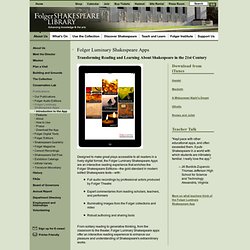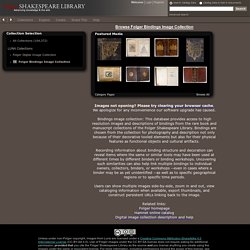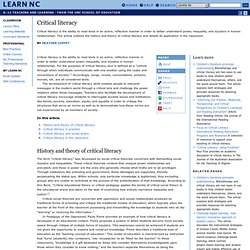

Shakespeare and online video. Shakespeare, Our Digital Native. Shakespeare at MIT — Digital Projects and Related Sites. Digital Humanities: "Old Faithfuls" for Shakespeare Resources. Luminary Shakespeare Apps-Folger Shakespeare Library. Designed to make great plays accessible to all readers in a lively digital format, the Folger Luminary Shakespeare Apps are an interactive reading experience that enriches the Folger Shakespeare Editions—the gold standard in modern edited Shakespeare texts—with: Full audio recordings by professional actors produced by Folger Theatre Expert commentaries from leading scholars, teachers, and performers Illuminating images from the Folger collections and video Robust authoring and sharing tools From solitary reading to generative thinking, from the classroom to the theater, Folger Luminary Shakespeare apps offer an interactive reading experience to enhance our pleasure and understanding of Shakespeare's extraordinary works.

Chicago Shakespeare Theater: Handbooks. Each of our original teacher handbooks includes active, engaging teaching activities, 400 years of critical thinking, synopses, and much more.

Teaching activities—all aligned with the Common Core State Standards—are designed to draw upon some of the same practices and techniques that actors use in the rehearsal process to break open Shakespeare's challenging language. Asia, Shakespeare, and the World: Digital Resources for Teaching about Globalization. Parts of the world.

Take Hamlet for example. The pla was performed under varing conditions onboard the Red Dragon , a vessel of the East India Compan, near what is now Sierra Leone in 1607, onthe island of Socotra in 1608, and possibl in a Dutch fortress in Jaakarta in colonial Indonesia in 1609. As the centuries wore on, Shakespeare was made to speak in a diverse range of tongues for and againstthe same political causes in Asia and beond, such as Communism and imperialism. Tempest that use Shake-speare to rethink Korean histor. As You Like It. DHQ: Digital Humanities Quarterly: The Radical Historicity of Everything: Exploring Shakespearean Identity with Web 2.0. Abstract This article presents the results of a semester-long project designed to determine how effectively interactive Web 2.0 technology can facilitate collaborative research in undergraduate learners.

The study was conducted during a 2007 advanced Shakespeare course at the University of Central Florida that focused heavily on a new historicist approach to studying literature. In this paper we first establish the theoretical foundation for this particular approach to literary studies, then discuss more in-depth how the collaborative, inter-connective nature of wikis allowed students to witness first-hand some of the concealed assumptions enmeshed in the creation of historical explanation or narrative. We also discuss how, in thinking about the past, this technology allowed our students realize some of the stakes in describing history for the present.
People in Shakespeare’s time ate drum sticks and lived short, dirty lives. Everyone loved Queen Elizabeth... Shakespeare and the Book. Shakespeare in His Time and for All Time. Shakespeare Library Bindings Image Collection. Images not opening?

Please try clearing your browser cache. We apologize for any inconvenience our software upgrade has caused. Bindings image collection: This database provides access to high resolution images and descriptions of bindings from the rare book and manuscript collections of the Folger Shakespeare Library. Bindings are chosen from the collection for photography and description not only because of their decorative tooled elements but also for their physical features as functional objects and cultural artifacts. Recording information about binding structure and decoration can reveal items where the same or similar tools may have been used at different times by different binders or binding workshops. Users can show multiple images side-by-side, zoom in and out, view cataloging information when available, export thumbnails, and construct persistent URLs linking back to the image. Related links: Folger homepageHamnet online catalogDigital image collection description and help.
Folger Shakespeare Library: Shakespeare in American Life. Critical literacy. Critical literacy is the ability to read texts in an active, reflective manner in order to better understand power, inequality, and injustice in human relationships.

For the purposes of critical literacy, text is defined as a “vehicle through which individuals communicate with one another using the codes and conventions of society”. Accordingly, songs, novels, conversations, pictures, movies, etc. are all considered texts. The development of critical literacy skills enables people to interpret messages in the modern world through a critical lens and challenge the power relations within those messages. In this article History and theory of critical literacy The term “critical literacy” was developed by social critical theorists concerned with dismantling social injustice and inequalities.
In Pedagogy of the Oppressed, Paulo Freire provides an example of how critical literacy is developed in an educational context. Critical literacy in practice Critical literacy and social action Other methods.
Teaching Hamlet.